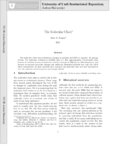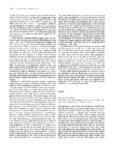Filters: Department: "Anthropology" Collection: "ir_uspace" Type: "Text" Format: "application/pdf" School Or College: "College of Social & Behavioral Science"
| Creator | Title | Description | Subject | Date | ||
|---|---|---|---|---|---|---|
| 101 |
 |
Codding, Brian | Alternative aboriginal economies: Martu livelihoods in the 21st century | In the western deserts of Australia, hunting and gathering endures as an important social and economic activity. That foraging persists within the boundaries of developed industrialized nation states may come as a surprise to those who evaluate foraging as less profitable than agricultural, wage or ... | Aboriginal economics; Aboriginal foraging | 2015 |
| 102 |
 |
Hawkes, Kristen | Hunting and the evolution of egalitarian societies: lessons from the Hadza | Political hierarchies are common in human societies but absent among many mobile hunter-gatherers. So egalitarian social organizations have been attributed to limits that foraging imposes on wealth accumulation. But male-dominance hierarchies characterize all the great apes, our nearest relatives. ... | 2000 | |
| 103 |
 |
Codding, Brian F. | External impacts on internal dynamics: Effects of paleoclimatic and demographic variability on acorn exploitation along the Central California coast | Research into human-environment interaction in California prehistory often focuses on either the internal dynamics of adaptive decisions or the external impacts of environmental change. While both processes were surely driving prehistoric variability, integrating these approaches is not altogether s... | Acorn exploitation; Prehistoric land use; Behavioral ecology | 2016 |
| 104 |
 |
Rogers, Alan R. | The molecular clock | The molecular clock uses evolutionary changes in proteins and DNA to measure the passage of time. Yet molecular evolution is clocklike only to a first approximation. Uncertainties arise because of variation in rates of molecular evolution, because of difficulty in calibrating clocks, and because we ... | 2013-01-01 | |
| 105 |
 |
Hawkes, Kristen | On why male foragers hunt and share food: Reply to Hill and Kaplan | My argument is this: Some food resources, notably large animals when they are unpredictably acquired, are too expensive to defend. Other can claim shares of them without repaying shares of the same foods later. | 1993-01-01 | |
| 106 |
 |
Codding, Brian F. | Environmental productivity predicts migration, demographic, and linguistic patterns in prehistoric California | Global patterns of ethnolinguistic diversity vary tremendously. Some regions show very little variation even across vast expanses, whereas others exhibit dense mosaics of different languages spoken alongside one another. Compared with the rest of Native North America, prehistoric California exemplif... | Colonization of North America; Prehistoric migrations; Human behavioral ecology; Ideal free distribution; Ideal despotic distribution | 2013-09-03 |
| 107 |
 |
Broughton, John | Homestead cave Ichthyofauna | Biological evidence on the climatic and hydrographic history of the intermountain region would be much richer, if we had more than the present dribble of paleontological data on the fishes (Hubbs and Miller, 1948, p. 25). In this passage from their landmark synthesis of historical fish biogeograph... | Homestead Cave; Ichthyofauna; Lake Bonneville | 2000 |
| 108 |
 |
Rogers, Alan R. | Pleistocene population X-plosion? | In two recent papers, Kaessmann et al. presented DNA sequence data from the X chromosome (Xq13.3) of 30 chimpanzees and 69 humans (Kaessmann et al. 1999a; Kaessmann et al. 1999b). These data bear on two longstanding questions involving late Pleistocene demographic history: (1) whether the long-term... | 2000 | |
| 109 |
 |
Harpending, Henry C.; Rogers, Alan R. | Detecting positive selection from genome scans of linkage disequilibrium | Though a variety of linkage disequilibrium tests have recently been introduced to measure the signal of recent positive selection, the statistical properties of the various methods have not been directly compared. While most applications of these tests have suggested that positive selection has pl... | Genome scans; Linkage disequilibrium; Gene trees | 2010 |
| 110 |
 |
Rogers, Alan R. | Population differences in quantitative characters as opposed to gene frequencies | Hypotheses about evolution can be tested by comparing genetics differences with those of quantitative characters. Such comparisons are one source of information concerning the forces that maintain variation among natural populations. | Genes; Evolution; Anthropology | 1986-05 |
